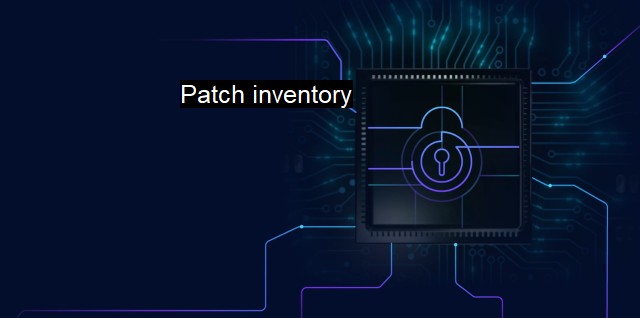What is Patch inventory?
Securing Your Systems: The Crucial Role of Patch Inventory Management in Cybersecurity
Patch inventory in the realm of cybersecurity mainly refers to accountability of the various patches currently deployed into an organization's multiple digital systems. A patch is essentially a software update prepared for an application, system, or even a whole network, which is specifically intended to correct vulnerabilities, fix bugs, and enhance overall security. Since an unpatched system often plays a role in data breaches, having a robust and up-to-date patch inventory is critical to an organization's cybersecurity strategy.It is indispensable to understand the intricate connection between patch inventory and antivirus solutions. An antivirus, traditionally, is software that protects systems against malicious programs. While it does a commendable job detecting and blocking such threats, it cannot address software vulnerabilities. That’s where patching comes into play, fixing existing security gaps and preventing potential exploits.
In the broader sense, the creation of a patch inventory involves the complete documentation of all patches applied to an organization’s technical infrastructure. This inventory provides an overview of the patch status across different systems and apps, which is crucial for effective vulnerability management.
Patch inventory isn't merely a laundry list of patches, though. It provides critical insight into how robust an organization's cybersecurity measures are. An updated patch inventory can point out sparsely defended or poorly updated systems that, if left ignored, can invite cyber risks. The nature of the cybersecurity landscape demands vigilance and proactivity, as new threats and vulnerabilities emerge all the time. In such an environment, a meticulously compiled and maintained patch inventory contributes massively to cybersecurity maintenance.
Being aware of your patch inventory becomes even more critical considering the ever-increasing number of cyber threats. Notably, when a new virus, worm, or malware is detected, vendors work on producing patches to counter the new threat. Antivirus software might prevent an infection from a known virus. Still, without the application of these new patches, systems remain susceptible to emerging threats.
Patch inventory management allows organizations to balance between maintaining system functionality and diminishing security risk. Applying patches wholesale may seem beneficial from a security standpoint; patches can conflict with currently active systems, causing disruptions and potential downtime. By having a well-maintained patch inventory that tracks the system's vulnerabilities, you can triage and prioritize patches to minimize disruption while maximizing security.
Compliance regulations such as PCI DSS, HIPAA-HITECH, and SOX underscore the need for patch inventory. These regulations mandate routine vulnerability scanning and timely rectification, which isn't feasible without proper patch management and tracking. By proactively managing and documenting the patch inventory, organizations demonstrate due diligence towards compliance, consequently avoiding hefty fines and penalties.
Managing a patch inventory is a challenging task. Given the complexity and breadth of modern-day IT infrastructures, tracking every patch across an organization's network can be daunting and resource-intensive. This is where automated tools can be utilized. Many organizations implement automated patch management systems which can make inventory maintenance more manageable. By doing so, they not only ensure real-time updating of their inventory but also free cybersecurity personnel to focus on broader data security strategies.
Patch inventory is a fundamental part of any effective cybersecurity strategy. Thorough, continuous patch inventory enhances virus and malware defense, fuels efficient vulnerability management, supports compliance missions, and guards against threat landscape dynamism. Given the continuous growth and development of software applications and digital systems as well as the unpredictability of cybersecurity threats, maintaining an accurate and updated patch inventory remains not just necessary, but vitally integral to the security health of any organization.

Patch inventory FAQs
What is patch inventory?
Patch inventory is a record of all the patches, updates, and hotfixes applied or needed for a software, operating system, or hardware. It is important in cybersecurity to ensure that all systems are updated with the latest security patches for antivirus, firewalls, or any other security software.Why is patch inventory important in cybersecurity?
Patch inventory is essential in cybersecurity because it helps to prevent security vulnerabilities that can be exploited by attackers. Cybercriminals often target systems with outdated software or operating systems, so maintaining a patch inventory and keeping all software up-to-date helps to prevent cyber attacks.How can I create a patch inventory?
To create a patch inventory, you need to identify all the software, operating systems, and hardware in your network. You can use patch management tools to automate the patch inventory process, scan the network for vulnerable systems, and apply patches. It's important to maintain accurate records and documentation of all patches and updates.What are the benefits of a patch inventory?
The benefits of a patch inventory include increased security, reduced risk from cyber attacks, improved compliance, and increased system reliability. By maintaining an accurate inventory of all patches and updates, you can ensure that all systems are up-to-date with the latest security patches, which can help to prevent data breaches and other cyber attacks. Additionally, patch inventory helps to ensure compliance with regulatory requirements while maintaining the overall health and reliability of the network.| | A | | | B | | | C | | | D | | | E | | | F | | | G | | | H | | | I | | | J | | | K | | | L | | | M | |
| | N | | | O | | | P | | | Q | | | R | | | S | | | T | | | U | | | V | | | W | | | X | | | Y | | | Z | |
| | 1 | | | 2 | | | 3 | | | 4 | | | 7 | | | 8 | | |||||||